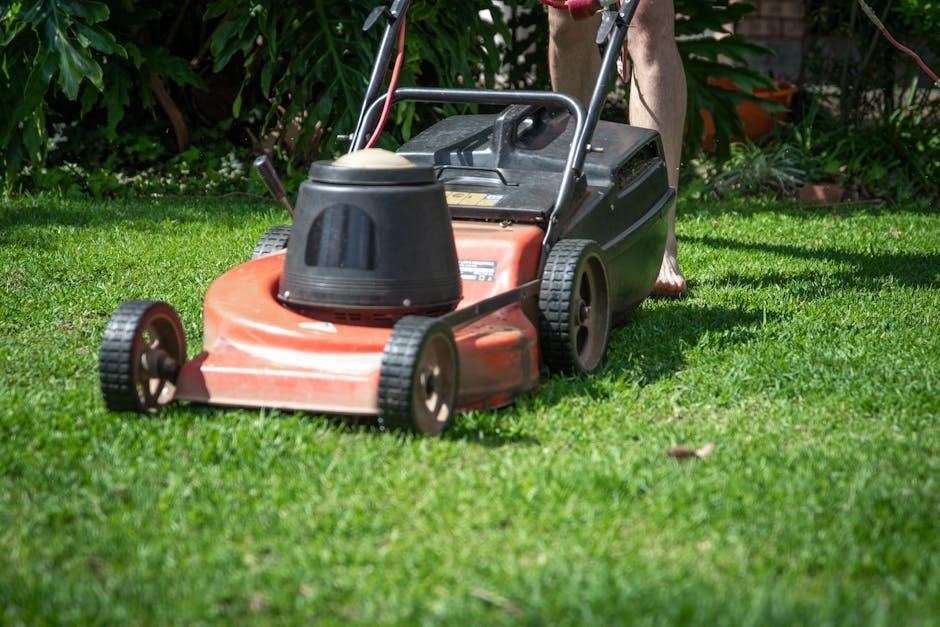Safety Precautions
- Always disengage blades when not mowing and stop the engine before cleaning or repairing․
- Wear substantial footwear; never operate barefoot or in open sandals․
- Ensure all moving parts have stopped before performing maintenance․
General Safety Guidelines
Always read and follow the instructions in this manual carefully before operating your Craftsman lawn mower․ Ensure you understand all safety precautions to avoid accidents․ Never operate the mower when barefoot or wearing open sandals; wear sturdy footwear and protective clothing․ Keep loose clothing and long hair tied back to avoid entanglement with moving parts․ Children and pets should be kept at a safe distance while mowing․ Avoid mowing in wet conditions or during strong winds, as this can increase the risk of slipping or debris being thrown․ Never leave the mower unattended while it is running․ If someone enters the mowing area, stop the machine immediately․ Always disengage the blades and allow the mower to come to a complete stop before performing any maintenance or repairs․
Protective Gear Recommendations
Wearing proper protective gear is essential to ensure safe operation of your Craftsman lawn mower․ Always wear safety glasses or goggles to protect your eyes from debris․ Hearing protection, such as earplugs, is recommended to reduce noise exposure․ Wear sturdy, closed-toe shoes or boots to prevent foot injuries․ Long pants and long-sleeved shirts can help protect your skin from cuts and abrasions caused by flying grass clippings or debris․ Gloves are also recommended to improve grip and reduce fatigue while operating the mower․ Avoid loose jewelry or clothing that could get caught in moving parts․ For additional protection, consider wearing a dust mask when mowing in dry or dusty conditions․ By following these guidelines, you can minimize the risk of injury and ensure a safer mowing experience․
Operating in Safe Environments
Always operate your Craftsman lawn mower in a clear, open area free from obstacles, children, and pets․ Avoid mowing on steep slopes or uneven terrain, as this can cause loss of control․ Never mow in reverse unless absolutely necessary, and always look behind you before doing so․ Keep the mower blade engaged only when moving forward․ Avoid operating the mower in extreme weather conditions, such as heavy rain or lightning storms, as this can increase the risk of accidents․ Ensure the area is well-ventilated to prevent the buildup of exhaust fumes․ Never operate the mower near open flames, sparks, or hot surfaces․ If someone enters the mowing area, stop the engine immediately․ Always shut off the engine and allow all parts to stop before leaving the mower unattended․ Properly store the mower in a well-ventilated area, away from flammable materials, and never store it with gasoline in the tank inside a building․
Assembly and Preparation

Unpack and inventory all parts carefully․ Attach handles and accessories following the manual․ Perform pre-operation checks, including blade inspection and control adjustments, before first use․
Unpacking and Inventory of Parts
Begin by carefully unpacking the lawn mower from its shipping container․ Inspect the unit for any visible damage during transit; Next, verify the completeness of the shipment by cross-referencing the parts list provided in the owner’s manual․ Ensure all components, such as handles, accessories, and hardware, are included․ Organize the parts in a clean, dry workspace to avoid misplacement․ If any items are missing or damaged, contact the manufacturer or supplier immediately for assistance․ Once satisfied with the inventory, proceed to the assembly phase, following the manual’s instructions for attaching handles and accessories․ Always refer to the manual for specific guidance on identifying and preparing each part for assembly․ Proper organization and verification at this stage ensure a smooth and efficient assembly process․
Attaching Handles and Accessories
Begin by unpacking the handles and accessories from the shipping materials․ Locate the bolts, locknuts, and washers provided for assembly․ Align the handlebars with the designated mounting points on the mower, ensuring proper alignment for secure attachment․ Tighten the bolts firmly using a wrench or socket, but avoid over-tightening to prevent damage to the threads․ Once the handles are securely in place, attach any additional accessories such as the grass catcher or mulching kit, following the manual’s specific instructions․ Make sure all connections are stable and properly aligned․ Adjust the handle height if necessary to ensure comfortable operation․ Double-check all bolts and connections to ensure they are tightened securely before proceeding to pre-operation checks․ Proper assembly of handles and accessories is crucial for safe and efficient mowing operations․ Always refer to the manual for detailed guidance on specific attachments․
Pre-Operation Checks and Adjustments
Before starting the lawn mower, perform a thorough pre-operation inspection to ensure safe and efficient operation․ Begin by checking the oil level using the dipstick, ensuring it is at the recommended level․ Inspect the tire pressure and inflate if necessary, as specified in the manual․ Verify that all bolts and nuts are tightened securely, especially on the handlebars and mowing deck․ Check the blade for sharpness and damage; a dull or damaged blade can leave uneven cuts and pose safety risks․ Remove any debris from the mowing deck and chute to ensure proper airflow and cutting performance․ Adjust the mowing height to the desired level, making sure it is even on all sides․ Finally, test the throttle and brake controls to ensure they function smoothly․ Always consult the manual for specific adjustments and recommendations to maintain optimal performance․ Proper pre-operation checks help prevent accidents and extend the lifespan of your mower․

Operating the Lawn Mower
Start the engine according to the manual, then engage the mower deck․ Maintain a steady pace, mowing in overlapping passes․ Stop the engine when leaving the mower unattended․
Starting and Stopping the Engine
To start the engine, ensure the mower is on a level surface and the parking brake is engaged․ Turn the ignition switch to the “start” position and gently pull the starter cord until resistance is felt․ Release the cord and allow the engine to warm up for a few seconds before engaging the mower deck․
- Always disengage the mower deck before stopping the engine․
- Stop the engine and allow all moving parts to come to a complete stop before leaving the mower unattended․
- Never stop the engine while the mower is in motion; always slow down and come to a complete stop first․
For extended storage, ensure the engine is cool and the fuel tank is empty or properly stabilized according to the manufacturer’s instructions․
Basic Mowing Techniques
For optimal results, maintain a steady pace while mowing, overlapping passes slightly to ensure even cutting․ Start by mowing in a consistent pattern, such as up and down in straight lines, to cover the lawn efficiently․ Avoid cutting more than one-third of the grass blade length in a single pass to prevent stressing the lawn․
- Adjust the mower deck height according to the type of grass and the desired height․
- Keep the mower blade sharp to ensure clean cuts and prevent tearing the grass․
- Turn the mower at edges or obstacles carefully to maintain control and avoid scalping the lawn․
Regularly empty the grass catcher or deflector to ensure proper discharge and maintain mowing efficiency․
Handling Different Terrain and Obstacles
Adapt your mowing technique to the terrain for efficient and safe operation․ When dealing with slopes, mow up and down to maintain stability and prevent tipping․ For uneven ground, reduce speed and use a lower gear to maintain control․
- Slopes and Hills: Mow up and down slopes, not side to side, and use a slower pace to maintain traction․
- Obstacles: Navigate carefully around trees, gardens, and rocks․ Disengage the blades when approaching large obstacles to prevent damage or injury․
- Uneven Terrain: Adjust the mower deck height to accommodate ground variations and avoid scalping the lawn․
- Tight Spaces: Use the mower’s turning radius effectively for tight turns and consider making wider turns to maintain control․
Clear debris before mowing to ensure smooth operation and prevent blockages․ Adjusting the mower settings, such as gear and blade height, can help manage challenging terrain effectively․
Maintenance and Troubleshooting
Regular maintenance is crucial for optimal performance․ Check and replace worn parts, address issues promptly to prevent breakdowns, and ensure all components function correctly․
Regular Maintenance Checks
Regular maintenance ensures your Craftsman lawn mower operates efficiently and extends its lifespan․ Start by inspecting the mower deck for debris buildup and damage․ Clean it thoroughly after each use to prevent rust and maintain cutting performance․ Check the oil level and top it off as needed, using the recommended type specified in the manual․ Sharpen the blade at least once a season to ensure clean cuts and prevent tearing the grass․ Additionally, inspect the air filter and replace it if dirty or clogged, as this affects engine performance․ Finally, check the tire pressure and adjust it according to the manufacturer’s guidelines for stability and even mowing․
Blade Maintenance and Replacement
Proper blade maintenance is essential for optimal performance and safety․ Regularly inspect the blade for dullness, damage, or wear․ A dull blade tears grass, leaving it vulnerable to disease, while a damaged blade can throw debris․ Sharpen the blade at least once a season using a file or grinder, ensuring the cutting edge remains sharp and balanced․ If the blade is severely damaged, replace it with a genuine Craftsman part to maintain mower efficiency and safety․ When replacing the blade, always wear gloves, disconnect the spark plug, and follow the manual’s instructions carefully․ Tighten the blade bolt to the specified torque to prevent vibration and ensure secure operation․ Regular blade upkeep ensures clean cuts, reduces wear on the mower, and promotes healthy lawn growth․
Winter Storage and Preparation

Proper winter storage ensures your Craftsman lawn mower remains in optimal condition for the next mowing season․ Before storing, drain the fuel tank or add a fuel stabilizer to prevent degradation․ Clean the mower thoroughly, removing dirt and debris from the deck and blades․ Apply a rust-inhibiting oil to metal parts to protect against corrosion․ Store the mower in a dry, protected area, such as a garage or shed, away from direct sunlight and moisture․ Do not store the mower with gasoline in the tank inside a building․ Wrap the mower in a breathable cover to prevent condensation buildup․ Ensure all moving parts are secure and tightly fastened to avoid damage during storage․ Proper winter preparation extends the lifespan of your mower and ensures it operates efficiently when spring arrives․

